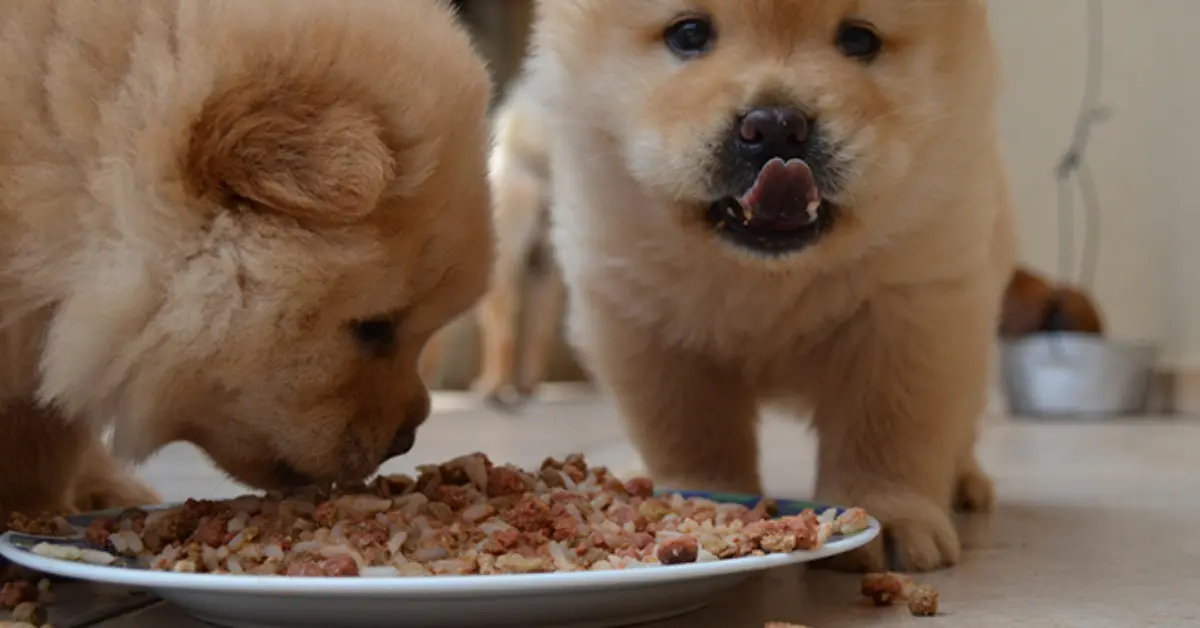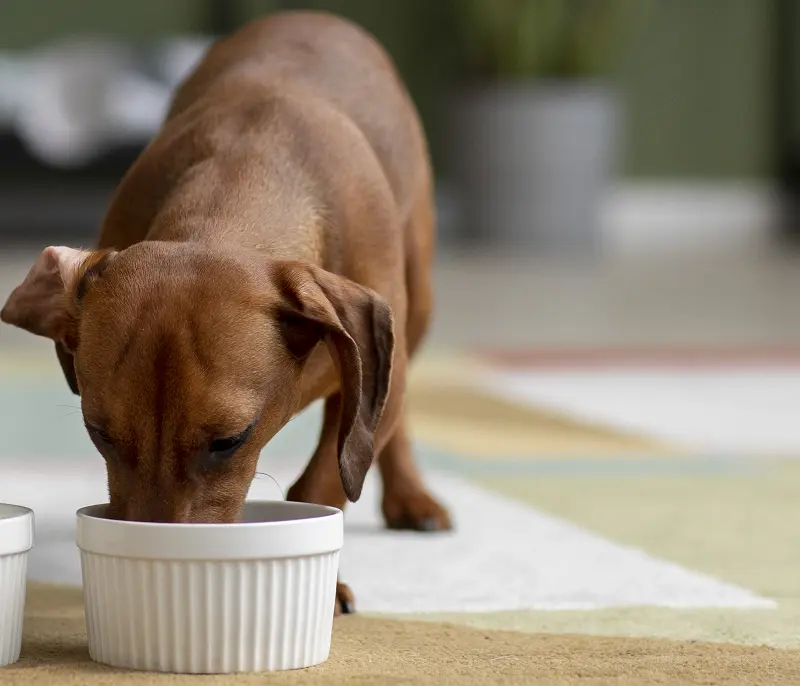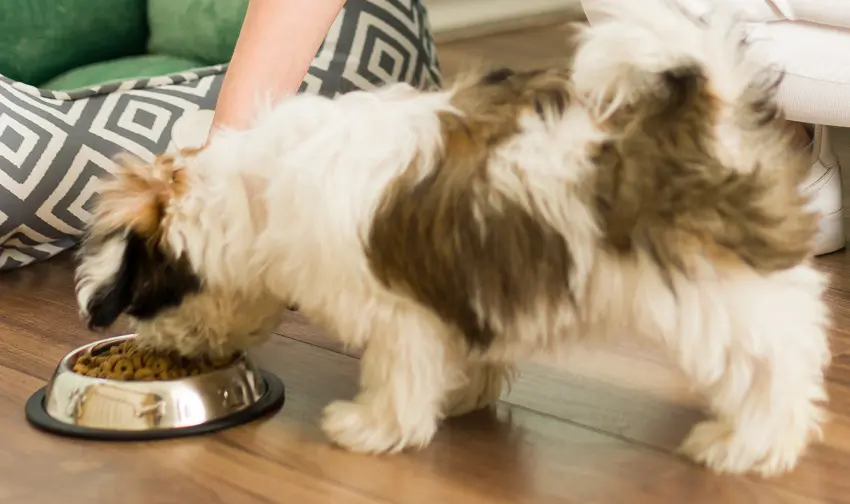When To Stop Wetting Puppy Food? Here’s The Answer!
Due to their small mouths and tiny teeth, a puppy’s food needs to be softened or soaked. However, many first-time dog owners are wondering how and when to stop wetting puppy food.
In this post, I will share my personal experience weaning my dog from softened food together with information on how to do it. If you have doubts, it’s always best to consult your dog’s veterinarian for the best advice.

When do I stop wetting my puppy’s food?

During the first weeks of a puppy’s life, it needs to consume soft food. This is due to their lack of strong teeth and their digestion is yet to be developed.
With that, puppy owners add warm water or broth to soften up their pet’s kibble. This turns the crunchy kibble into a mashed food similar to porridge.
Overall, it’s safe to soften or wet your puppy’s food. However, the time will come that you have to stop this practice.
One main reason for this is that softened food doesn’t encourage chewing. This will make your dog prone to plaque and tartar buildup.
Also, your dog will be difficult to feed later on as it got used to having its food softened first. In the end, your grown dog would only eat soggy kibble, which takes more time to prepare.
Aside from that, soaking kibble makes it prone to contamination. Also, it can lead to fermentation, which will make the dog food unsafe for consumption.
Most of the time, soaked or wet food is introduced to puppies at the age of four weeks. After that, the puppy will have to be weaned at 12 weeks old.
The good thing is that most puppies that came from breeders have already been weaned from soaked food. This is because most puppies will only be sold once it reaches 8 to 12 weeks of age.
However, if you’re caring for a very young puppy, you have to make the transition carefully. This way, the doggo will not start to refuse food or become fussy with its food choices.
How to wean your puppy from soft food?
Once your puppy has reached 8 to 10 weeks old, it’s important to start the weaning process. The process is simple and most puppies adjust well in a week or two.
Start by shortening the soaking period of your pup’s food. This way, its teeth will get used to eating stiffer food over the next few days.
Remember that you should never switch instantly to dry food. When you do this, your pup probably refuses to eat anything.
However, if your puppy isn’t taking the transition well, you may need to consult your pet’s veterinarian. Some dogs tend to prefer wet food over kibble, which is still fine.
After a few days, you can stop soaking then simply pour warm broth into your pup’s food. The added moisture will help the dog chew the dry food easily.
How do you soak dry food for puppies?

When puppies turn four weeks old, they will be transitioned to soaked dry food. This way, the growing pups will be weaned off their mother’s milk or the puppy formula.
To soak your pup’s dry food, you simply have to pour warm water over it. You can also use unsalted broth for added flavor and nutrients.
After that, leave the dry food soaking for 10 minutes. If the pieces are still stiff after that, soak them for another five minutes.
Take note that you should never soak your dog’s food for too long as this will start fermentation. When that happens, microorganisms will form on the food, which can mess up your puppy’s stomach.
Also, it’s important to cover the food as it soaks. This is to prevent insects or contaminants from getting into your puppy’s meal.
Once you’re satisfied with how soggy the dog food is, the next step is to check the temperature. Make sure that it’s cool enough for your puppy to eat.
Can you mix hard and soft puppy food?
It’s fine to mix hard and soft puppy food as long as the products have complementing nutritional profiles. The same goes when mixing two different dog food brands.
Mixing soft and dry food is a good way to transition your puppy to its new diet. You can start by replacing a quarter of its meal with one of the food types then slowly building your way up.
Moreover, pet owners mix soft and hard food to encourage picky eaters to eat. The smelly and flavorful nature of wet food matches the crunchiness of dry food.
How often should dogs have wet food?
The frequency of feeding your pet with dog food depends on its overall health and preference. Many dogs eat a wet-only diet since it provides them added hydration and they refuse to consume dry food. Please read here: Can Dry Dog Food Go Bad in Heat
Still, vets recommend that you encourage your dog to transition to kibble. While wet food isn’t really bad, it takes away the benefit of reducing plaque buildup by chewing crunchy food.
Is it bad to feed a puppy wet food all the time?
Wet food is a good choice for puppies, especially those who just got weaned from their mother. Still, it’s common practice to switch puppies to dry food after a few months.
One downside to wet food is that it contains more fat than dry food. Also, wet dog products are prone to spoilage and contamination.
But if your dog thrives in wet food and the vet recommends it, I don’t think there’s a problem with this diet. Just make sure that you’re serving your dog high-quality wet food that meets its nutritional needs.
How much wet food should a puppy eat in a day?
The amount of food your puppy needs depend on its body weight. In general, a puppy needs to eat 3 ounces of wet food for every 3.5 lbs. of body weight each day. Please read here: How Much to Feed Your Dog
This amount is on a sliding scale, depending on your dog’s health and the amount of treats your pup gets in a day.
Also, the entire serving of wet food should be divided into four to five meals. Once your puppy reaches a year old, you can reduce start feeding twice a day.
Conclusion
Knowing when to stop wetting puppy food will save you from the hassle. Also, it will allow your puppy to transition into a dry dog food formula.
Taking the process slowly is necessary to ensure that your pup will not become picky. Also, you can consult your pup’s veterinarian for added tips and methods.
